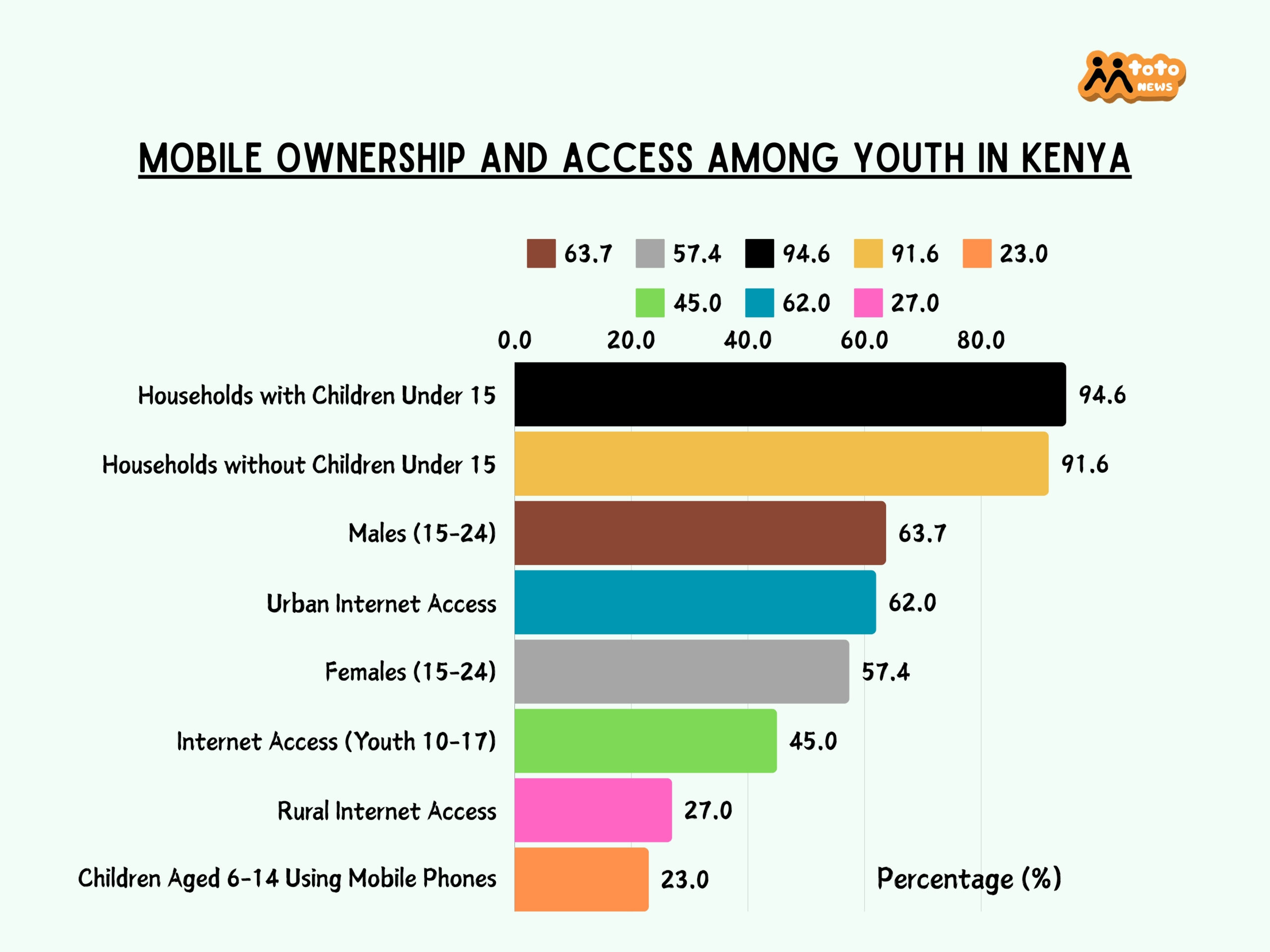Households with children under the age of 15 have shown a higher rate of ICT gadget adoption, according to a report by the Kenya National Bureau of Statistics (KNBS) and the Communications Authority of Kenya.

Mobile phones have become indispensable in modern life, and children are no exception to this trend. Recent data by Communications Authority of Kenya (CA) and Kenya National Bureau of Statistics (KNBS) has shown significant patterns in mobile and smartphone usage among children and young people. The Future is Digital, as we have already been saying.
Key Statistics on Mobile Ownership Among Children
The 2022 Kenya Demographic and Health Survey (KDHS) provides critical insights into mobile phone ownership among young people, particularly those aged 15-18.
Among males in this age group, about 63.7% males from age 15 to 24 year old owned a mobile phone, while slightly fewer females (about 57%) reported ownership.
In terms of smartphones, which provide advanced capabilities and access to online services, about two in five males and one in three females in the 15-24 age group owned a smartphone. A separate analysis from the ICT Access Survey 2022 revealed that almost half of individuals aged 15-18 had access to mobile devices, reflecting an upward trend compared to previous years.
Younger Children and Household Trends
Although specific ownership statistics for children under 15 are not directly available, data suggests that younger children also benefit from access to mobile technology. A 2024 report by the Kenya National Bureau of Statistics (KNBS) and the Communications Authority of Kenya indicates:
Households with children under 15 years show a mobile phone ownership rate of 94.6%, which is higher compared to 91.6% in households without younger children.
Additionally, findings show that in households with children aged 6-14, approximately one-quarter of children had used a mobile phone at least once, often for educational purposes or entertainment. This suggests that even if children under 15 do not own mobile phones, they likely have shared access within their homes, with family smartphones being used for educational apps, games, and communication with relatives.
Urban and Social Media Trends
In urban areas, such as Nairobi, studies highlight even higher levels of mobile access among youth aged 14-24.
Around seven in ten individuals in this group had access to a mobile phone, and nearly half had access to a smartphone. Among those with smartphones, a striking 90% used social media platforms such as Facebook and WhatsApp. These figures underline the centrality of mobile phones in the social lives of urban youth. Additionally, the ICT Access Survey revealed that among children aged 10-17, about half reported having access to the internet, primarily through shared smartphones or school-provided digital resources.
How Mobile Technology Impacts Children
Mobile devices are transforming childhood experiences across education, entertainment, and social interaction. Smartphones provide children with access to online learning resources, educational apps, and digital classrooms, fostering educational growth. They also serve as entertainment hubs, with children using mobile devices for gaming, video streaming, and music.
For teenagers, mobile phones are essential tools for staying connected with friends and family. For younger children, mobile devices often introduce them to technology, with child-friendly apps offering both playful and educational content.
The Challenges of Increasing Connectivity
While mobile technology offers numerous benefits, it also brings several challenges. Managing screen time is important to ensure that children balance productive use with the risks of overuse.
Online safety remains a significant concern, as children may be vulnerable to cyberbullying, harmful content, and online predators. There is also a growing digital divide, with disparities in access to technology across different socioeconomic groups.
The ICT Access Survey identified that only about one in four rural households with children under 18 had access to reliable internet, compared to about two-thirds in urban areas. This highlights the digital divide that could hinder educational opportunities for children in underserved regions.
Moving Forward, How Can We Make Technology Work for Children
As mobile phone and smartphone penetration rates continue to rise, it is important to guide their use among children. Parents, educators and policymakers must work together to ensure safe usage by implementing robust online safety measures, promoting balanced access by encouraging appropriate screen time and usage, and expanding inclusivity by increasing access to technology for marginalized groups.
